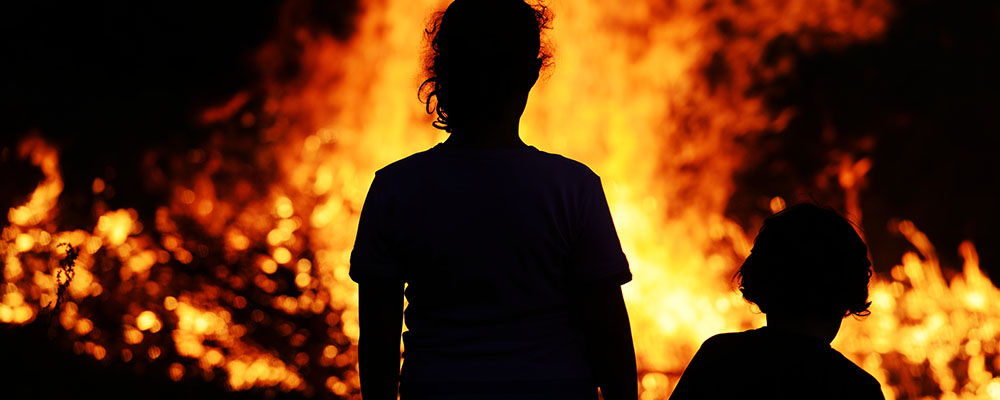
By Laura M. Stough and Elizabeth McAdams Ducy
Implications for Public Health
Planning for children with special healthcare needs and their families can help mitigate the negative impact of disasters. Emergency kits and emergency plans are necessary for all families, and especially important for families of children with these needs.
As wildfires raged through California, Paul—a preschooler with asthma and developmental disabilities—was home from school recuperating from a recent illness. Later that night, however, the fires advanced and his mother had to make the decision to evacuate.
In the rush, she grabbed some needed items, such as his inhaler, but left other health-related equipment and supplies behind. Although Paul’s mother had prepared to shelter-in-place in the event of an earthquake, she did not have a plan for evacuating quickly, nor for being away from home for an extended period of time. As it turned out, the family was displaced for almost two weeks and were forced to move to multiple temporary housing situations, including hotel rooms and friends’ homes.
While displaced, Paul’s mother faced challenges such as pureeing his food without a blender and improvising a makeshift air purifier. Unfortunately, though, Paul’s health rapidly deteriorated and he required multiple doctor visits. Physicians determined that smoke from the fires was exacerbating his preexisting health issues and they admitted him to the hospital. Paul missed more than a month of school because of his prolonged hospital stay, which then led to a decline in his behavioral, academic, and communication skills.
Paul is part of a study we conducted on the experiences of children with special health care needs (CSHCN) during the California wildfires. His plight highlights the many difficulties that families with children with disabilities face during evacuation and sheltering.
The U.S. Department of Health and Human Services defines CSHCN as “those who have or are at increased risk for a chronic physical, developmental, behavior, or emotional condition and who require health and related services of a type or amount beyond that required by children generally.” It is estimated that nearly 20 percent of U.S. children under 18 have special health care needs such as asthma, cerebral palsy, anxiety, allergies, or epilepsy. Many CSHCN have difficulties with functions such as mobility, communication, or breathing that affect their daily activities.
Studies report that most CSHCN families are under prepared for disasters. These findings are concerning since these children often require special equipment, supplies, or medical care—access to which can be disrupted by environmental hazards or other emergencies. Research on CSHCN impacted by Hurricane Katrina found children not only experienced greater disruptions in medical care, but also sought care for new health problems more often and were more likely to develop secondary health problems than other children.
When rapid evacuation is required, as in Paul’s case, preparedness for CSHCN is particularly critical. These children can require specialized medical care, as well as durable medical equipment that must be evacuated along with them. When items such as wheelchairs, communication boards, special foods and supplements, oxygen machines, and assistance animals are not arranged for, the health and daily functioning of CSHCN can be negatively affected. Packing and accounting for these supports can be daunting, both during rapid evacuations or even when families have a longer timeframe to evacuate, such as in advance of hurricanes.
Once evacuated, CSHCN families face another set of obstacles. Often, after reaching a public shelter, hotel, or other temporary housing, accommodations and structural needs for their children are not present. In addition, as families transition to different temporary living spaces—as they often forced to do multiple times during disasters—their needs are often overlooked by voluntary agencies when they lose track of these families. As a result, CSHCN families experience stress in addressing their children’s critical health and functional needs on their own, while simultaneously dealing with the many challenges of a temporary living situation. More collaboration among voluntary agencies, disability organizations, healthcare providers, and hospitals is essential to help these families get needed supplies, equipment, and support during emergencies.
Even when not required to evacuate, sheltering in place during hazards—during a tornado or an ice storm, for instance—brings its own challenges. While most preparedness guidance suggests storing three to five days’ worth of food, water, and medicine, a severely impacted area can take longer to provide the specialized care and supplies that CSHCN require, suggesting that it might be particularly important for these families to prepare for even longer.
Steps are being taken to help CSHCN families become better prepared for environmental hazards—but there is still much more to be done. For instance, one intervention that proved highly successful involved healthcare providers distributing a disaster starter kit that included emergency health form to CSHCN families, which in turn promoted additional preparedness actions. Checklists for emergency kits can also be useful. There have also been public health interventions successful in increasing family preparedness by educating parents or incorporating preparedness into patient treatment plans. These types of interventions, however, are not yet widespread or regularly included into systems of care. Future interventions should translate and evaluate evidence-based practices to promote preparedness among CSHCN families.
Another promising technique is for teachers of students with disabilities to provide support to and communicate with families during disasters—but teachers are not typically trained to fulfill this role during emergencies. In addition, schools and childcare facilities do not consistently address the evacuation needs of CSHCN in disaster.
Another issue in play is that children with disabilities are often not included in emergency planning or training, which could increase their level of vulnerability when away from their parents. A case study of children with disabilities who experienced the 2010 Canterbury earthquakes found they had overall good understanding of potential hazards as well as actively participated in emergency preparedness. Although increased attention is being directed toward the disaster experiences of people with disabilities, evidenced-based interventions that include children with disabilities remain extremely limited.
Children are heavily reliant on family members and care providers to plan for evacuation- and children with disabilities or special health care needs are doubly so. Additional resources and response efforts that recognize the needs of CSHCN and their families, such as of Paul and his mother, can help mitigate the stress experienced by these families during evacuation and sheltering.
This article originally appeared in the Research Counts Children and Disasters Special Collection series on June 14, 2019. This is an updated version.
Suggested Tools
Emergency Information Form for Children with Special Healthcare Needs
American College of Emergency Physicians
Patient-specific emergency information form for children with special healthcare needs.
Emergency Kit Checklist for Families with Children and Youth with Special Healthcare Needs
Centers for Disease Control and Prevention
Checklist of items to include in an emergency kit for families with children and youth with special healthcare needs.
Getting To Outcomes Guide for Community Emergency Preparedness
RAND and University of California Los Angeles Center for Public Health and Disasters
Comprehensive guide to implementing evidence-based public health interventions in emergency preparedness.
For a list of all the tools included in this special collection, visit the Mass Sheltering Tool Index. A list of further readings are also available.

Laura Stough is a professor of educational psychology at Texas A&M University and leads Project REDD: Research and Education on Disability and Disaster at the Center for Disability and Development. She has produced more than 50 academic publications on the social, educational, and psychological experiences of individuals with disabilities, including the book Disaster and Disability: Explorations and Exchanges, co-edited with Ilan Kelman.